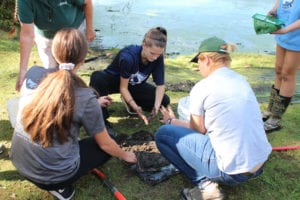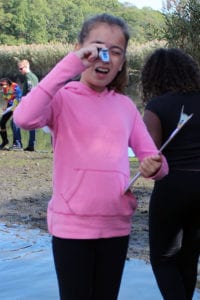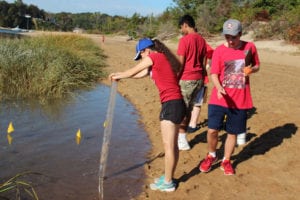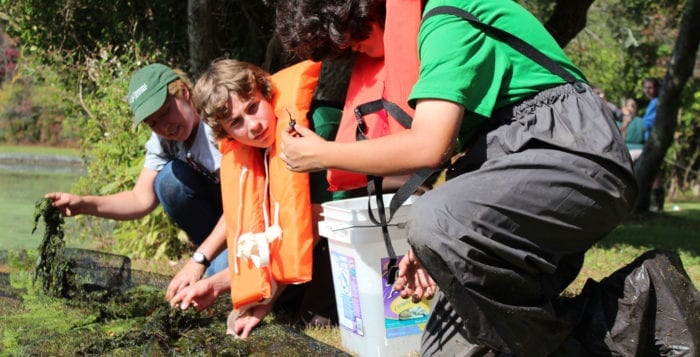By Sara-Megan Walsh
Hundreds of students from Smithtown to Northport got wet and dirty as they looked at what lurks beneath the surface of the Nissequogue River.
More than 400 students from 11 schools participated in “A Day in the Life” of the Nissequogue River Oct. 6, performing hands-on citizens scientific research and exploring the waterway’s health and ecosystem. The event was coordinated by Brookhaven National Laboratory, Central Pine Barrens Commission, Suffolk County Water Authority and New York State Department of Environmental Conservation.

“’A Day in the Life’ helps students develop an appreciation for and knowledge of Long Island’s ecosystems and collect useful scientific data,” program coordinator Melissa Parrott said. “It connects students to their natural world to become stewards of water quality and Long Island’s diverse ecosystems.”
More than 50 students from Northport High School chemically analyzed the water conditions, marked tidal flow, and tracked aquatic species found near the headwaters of the Nissequogue in Caleb Smith State Park Preserve in Smithtown. Teens were excited to find and record various species of tadpoles and fish found using seine net, a fishing net that hangs vertically and is weighted to drag along the riverbed.
“It’s an outdoor educational setting that puts forth a tangible opportunity for students to experience science firsthand,” David Storch, chairman of science and technology education at Northport High School, said. “Here they learn how to sample, how to classify, how to organize, and how to develop experimental procedures in an open, inquiry-based environment. It’s the best education we can hope for.”
Kimberly Collins, co-director of the science research program at Northport High School, taught students how to use Oreo cookies and honey to bait ants for Cold Spring Harbor Laboratory’s Barcode Long Island. The project invites students to capture invertebrates, learn how to extract the insects’ DNA then have it sequenced to document and map diversity of different species.

Further down river, Harbor Country Day School students explored the riverbed at Landing Avenue Park in Smithtown. Science teacher Kevin Hughes said the day was one of discovery for his fourth- to eighth-grade students.
“It’s all about letting them see and experience the Nissequogue River,” Hughes said. “At first, they’ll be a little hesitant to get their hands dirty, but by the end you’ll see they are completely engrossed and rolling around in it.”
The middle schoolers worked with Eric Young, program director at Sweetbriar Nature Center in Smithtown, to analyze water samples. All the data collected will be used in the classroom to teach students about topics such as salinity and water pollution. Then, it will be sent to BNL as part of a citizens’ research project, measuring the river’s health and water ecosystems.
Smithtown East seniors Aaron Min and Shrey Thaker have participated in this annual scientific study of the Nissequogue River at Short Beach in Smithtown for last three years. Carrying cameras around their necks, they photographed and documented their classmates findings.
“We see a lot of changes from year to year, from different types of animals and critters we get to see, or wildlife and plants,” Thaker said. “It’s really interesting to see how it changes over time and see what stays consistent over time as well. It’s also exciting to see our peers really get into it.”
Maria Zeitlin, a science research and college chemistry teacher at Smithtown High School East, divided students into four groups to test water oxygenation levels, document aquatic life forms, measure air temperature and wind speed, and compile an extensive physical description of wildlife and plants in the area.

The collected data will be brought back to the classroom and compared against previous years.
In this way, Zeitlin said the hands-on study of Nissequogue River serves as a lesson in live data collection. Students must learn to repeat procedures multiple times and use various scientific instruments to support their findings.
“Troubleshooting data collection is vital as a scientist that they can take into any area,” she said. “Data has to be reliable. So when someone says there’s climate change, someone can’t turn around and say it’s not true.”
The Smithtown East teacher highlighted that while scientific research can be conducted anywhere, there’s a second life lesson she hopes that her students and all others will take away from their studies of the Nissequogue River.
“This site is their backyard; they live here,” Zeitlin said. “Instead of just coming to the beach, from this point forward they will never see the beach the same again. It’s not just a recreational site, but its teeming with life and science.”





